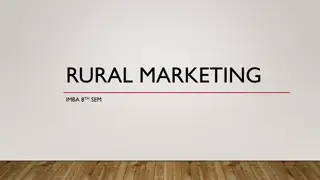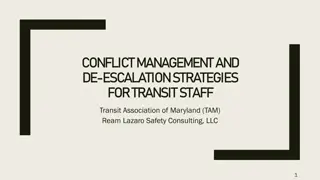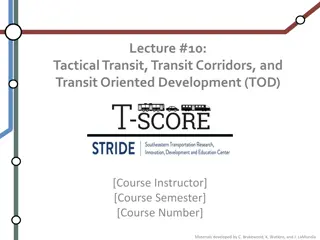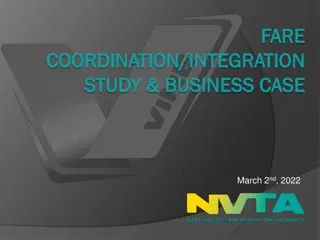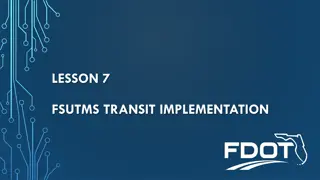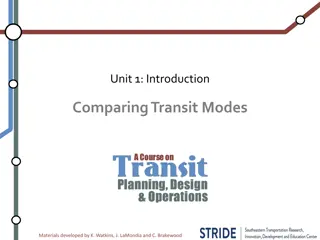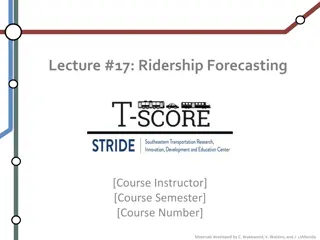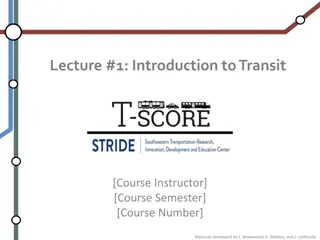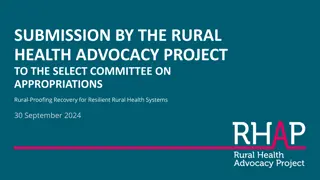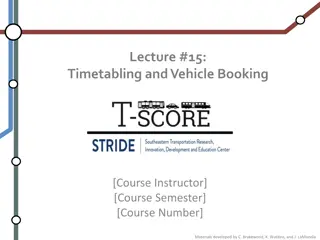Challenges and Best Practices for Small and Rural Transit Employers
Speaker Craig McNulty from Cahill Swift discusses the hurdles faced by small and rural transit employers in carrying out compliant drug and alcohol testing programs. Challenges include workload management, training limitations, unfavorable geography, and the need for qualified service agents. The importance of proper records storage and sharing, along with resources available for free at the FTA website, are highlighted for effective program implementation.
- Transit employers
- Drug and alcohol testing
- Compliance challenges
- Workload management
- Records storage
Download Presentation

Please find below an Image/Link to download the presentation.
The content on the website is provided AS IS for your information and personal use only. It may not be sold, licensed, or shared on other websites without obtaining consent from the author. Download presentation by click this link. If you encounter any issues during the download, it is possible that the publisher has removed the file from their server.
E N D
Presentation Transcript
Testing for Small and Rural Transit Employers: Challenges and Best Practices Craig McNulty Cahill Swift FTA Drug and Alcohol Program National Conference May 12, 2021
Speaker Craig McNulty Cahill Swift, Boston, MA 2
Hurdles to Compliant Testing Workload (and Records Storage) Training Unfavorable Geography Qualified Service Agents Testing Limitations 3
Hurdles to Compliant Testing All resources discussed can be found (for free) at: https://transit-safety.fta.dot.gov/DrugAndAlcohol/Tools/ 4
Workload Drug and alcohol program is buried. Scarce resources Management (sometimes) does not understand the importance. 5
Workload Information sharing between departments. Ensure necessary records are shared Appropriately organized and secured files. FTA s record keeping requirements 6 6
Workload and Records Storage What records do you keep? Test results Testing process administration Return-to-duty process administration Employee training Supervisor training 7 7
Records Storage Secure location with controlled access. Your TPA may keep them. Employer s responsibility that they are current, saved, and secured correctly 8 8
Records Storage One (1) Year: Negative drug test results Alcohol test results less than 0.02 Two (2) Years: Education and training records Records related to the alcohol and drug collection process Three (3) Years: Previous employer records Five (5) Years: Annual MIS reports Employee evaluation and referrals to SAPs Follow-up tests and follow-up schedules Refusals to test Alcohol test results 0.02 or greater Verified positive drug test results 9 9
Training DAPM was never trained. Or received ineffective training Only DAPM knows rules. There is no backup 10
Training Compliant policy. Will help establish required baselines Employee/supervisor training. 60-minute drug awareness Reasonable Suspicion (60/60) Post-Accident thresholds and timeframes Display and distribution of materials. 11
Unfavorable Geography Isolated location... Or multiple remote locations which lead to specific random, post-accident, and reasonable suspicion testing difficulties. 12
Unfavorable Geography Isolated location Inability to locate readily available Substance Abuse Professionals (SAPs) 13
Find a Qualified SAP Organizations approved by the Office of Drug and Alcohol Policy and Compliance (ODAPC) National Association of Alcoholism and Drug Abuse Counselors Certification Commission (NAADAC) https://www.naadac.org/sap-directory International Certification Reciprocity Consortium (ICRC) https://internationalcredentialing.org/memberboards National Board for Certified Counselors (NBCC) https://www.nbcc.org/search/counselorfind 14
Qualified Service Agents Medical Review Officer (MRO) Substance Abuse Professional (SAP) Urine Collector Screening Test Technician (STT)/Breath Alcohol Technician (BAT) Collection Site 15
Qualified Service Agents MRO Check qualifications Create easy reporting path SAP Check qualifications Must have at least two readily available SAPs Can use just a broker (as long as you have an agreement) 16
Qualified Service Agents Urine Collectors, STTs, and BATs Check qualifications Proactively ask collection site to send over any new hire s qualifications Error correction training (when necessary) 17
Qualified Service Agents Collection Site Check if EBT is on conforming products list (CPL): See ODAPC website: https://www.transportation.gov/odapc/Approved- Evidential-Breath-Measurement-Devices) Stop by: Check enclosure Check the sign-in process (no collection site specific consent form) Talk to manager, and/or collectors, and assure them it is ok to call you with any problem 18
Qualified Service Agents Collection Site Check incoming paperwork for errors Fix when required Note and file when completed See if appointments are available 19
Testing Limitations Random Post-Accident Reasonable Suspicion 20
Random Testing Reasonable testing spread to include: All times of the day that SS functions are performed Outside of administrative hours Early morning (especially alcohol) or late evening 21
Random Testing Reasonable testing spread to include: All days of the week that SS functions are performed Weekends 22
Random Testing Reasonable testing spread to include: All weeks of the month For monthly selections: ensure the timeliness of the selection list to include the first/last week of testing period 23
Random Testing Reasonable testing spread to include: All months of the year For quarterly selections: ensure the timeliness of selection list to include first/last weeks of the testing period 24
Random Testing Schedule tests ahead of time. Collaborate with others: Get help from supervisors to conduct tests on weekends, or outside regular work hours 25
Random Testing After hours testing: Hospital/Urgent Care Ensure DOT qualified collectors After-hours agreement with regular collection site Agreement with an individual collector 26
Random Testing Create your own random testing charts. FTA Tools and Resources website Update random pool before selection. Share with others in case of absence Reminder: At least 50% for drugs, 10% for alcohol. 27
Random Testing System with 10 safety-sensitive employees: 28
Random Testing System with 10 safety-sensitive employees: 29
Random Testing System with 10 safety-sensitive employees: 30
Post-Accident Establish decision making protocols. DAPM Dispatch Employee immediately reports accident. Interview employee over the phone. Talk to law enforcement, if possible 31
Post-Accident Take notes in real-time (or fill out form if you have one). Walk employee through the steps. If testing is required, send them immediately Clock starts at the time of the accident Not when you make your decision 32
Post-Accident Aside from thresholds, and employees being tested, your documentation must include: 655.44(a)(2)(ii): If an alcohol test required by this section is not administered within two hours following the accident, the employer shall prepare and maintain on file a record stating the reasons the alcohol test was not promptly administered. If an alcohol test required by this section is not administered within eight hours following the accident, the employer shall cease attempts to administer an alcohol test and maintain the record. Records shall be submitted to FTA upon request of the Administrator. 33
Post-Accident Aside from thresholds, and employees being tested, your documentation must include: 655.44(d): The decision not to administer a drug and/or alcohol test under this section shall be based on the employer's determination, using the best available information at the time of the determination that the employee's performance could not have contributed to the accident. Such a decision must be documented in detail, including the decision-making process used to reach the decision not to test. 34
Reasonable Suspicion Establish decision making protocols. Must happen in real-time. DAPM (or supervisor) mustgo to employee s location. Face-to-face 37
Reasonable Suspicion Have employee cease performance of SS functions. Document signs and symptoms of drug use and/or alcohol misuse upon arrival. Employees (not authorized) should know who to contact if suspicious. 38
Reasonable Suspicion and Post-Accident Testing Site If you are in a pinch: 40.221(e): If an alcohol testing site fully meeting all the visual and aural privacy requirements of paragraph (c) is not readily available, this part allows a reasonable suspicion or post-accident test to be conducted at a site that partially meets these requirements. In this case, the site must afford visual and aural privacy to the employee to the greatest extent practicable. 41
Questions? Craig McNulty Cahill Swift 617-314-9208 cmcnulty@cahillswift.com






